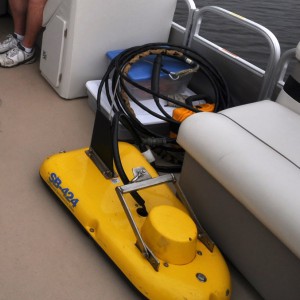Chirp Sub-bottom Profiler
A Sub-bottom profiler is a type of sonar system that produces a 2-dimensional stratigraphic cross section by using acoustic energy to image sub-surface features in an aquatic environment. While numerous types of sub-bottom profilers exist, we most frequently rely on our Edgetech 424 Chirp system. This system consists of a tow-fish (a transducer mounted inside in a protective body and towed behind or below our vessel), a tow cable, and a topside control unit. This system is reasonably portable and can be deployed off of large ocean going vessels for deep water operations, or canoes and rowboats for work in shallow water. A Chirp system emits an acoustic pulse (called a “ping”) from the transducer that travels down through the water column. When the ping hits the sediment some of that acoustic energy is reflected back towards the tow-fish. Based on the time it takes for the sound to travel down and back (called Two-Way Travel Time, or TWTT) and knowing the speed of sound through water (typically about 1500m/s) we can calculate the depth at a given location. If the bottom is hard and compact like bedrock or thick sand then most of the acoustic energy will be reflected back towards the surface preventing us from identifying its stratigraphy. If the bottom sediments are soft or loosely consolidated then some percentage of the ping will continue to travel through the bottom and into the sub-surface. As the sound energy passes through different materials (sands, clays, mud) some of that energy is reflected back towards the tow-fish. Based on the intensity of the returning signal and the time it took to return to the fish, we get an image of how thick the sediment package is at a given location, and what that package might be able to tell us about the site.
It is important to point out that a sub-bottom system does not identify sedimentary materials, but rather changes in the acoustic impedance of the subsurface geology. Changes in acoustic impedance can generally be thought of as changes in density which indicate transitions from one stratigraphic sequence to another.
The 424 operates on a frequency range of 4-24 kHz. This gives us the best balance of resolution and penetration. Lower frequency systems can penetrate further into the sub-surface (“See deeper into the mud”) but lack the capability of picking up the finer detailed stratigraphy that is of interest to us. Higher frequency systems, such as precision echosounders used in bathymetric mapping, provide finer detail and more accurate depth measurements, but lack penetrative power.

